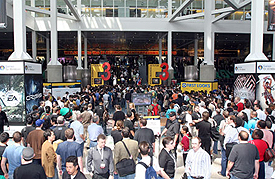Seven Must-Dos for PR at Tradeshows

Most businesses attend annual tradeshows in their industry. These can be smaller regional shows or large blockbuster extravaganzas like the Consumer Electronics Show (CES). The benefits of being live at an important show are obvious, but in order to really maximize your substantial investment of a tradeshow, a lot of thought and effort needs to be put into media relations at the event.
Many important press personnel or bloggers will attend tradeshows. Your goal is to meet with as many of them as possible. Here are some tips on how to make that happen:
1. Queue up important product launch or announcement press releases for distribution when the show starts. It’s not a coincidence that major news breaks at big tradeshows. This is done to coincide with a time and place where the press, analysts, influencers, buyers and consumers will all congregate. If you’re an exhibitor, sometimes the show organizer will have special wire distribution rates through PR Newswire or Business Wire.
2. Ask the show organizer for attending media contact list. Almost every tradeshow will have a spreadsheet with contact information of the attending media. If you’re a paid exhibitor, you have the right to access that list for show purposes. Make sure to ask your point of contact for that list and get it as soon as it’s available. Some shows send it out automatically to exhibitors. Others you have to ask. Be on the safe side and ask anyway.
3. Brainstorm strategy on how to entice the media with an invitation. Press people are busy. The greatest sin is wasting their time. Huddle with your internal marketing team and PR agency to think about the goals of a meeting and what the most attractive way to entice a reporter to come by would be. Perhaps it’s a sneak peek at a new product release? Or a demo of a new web or mobile app? Maybe your company has issued a new whitepaper on an important topic? If you are new to the industry, even an invitation to meet and present an overview of your company is fine. Just remember, don’t waste their time. Have a clear goal and think of a way to make it time well spent for the press.
4. Create a press kit. Press kits can be as simple as a Word document with the following information:
-Headquarters location
-Number of offices worldwide (if applicable)
-Number of employees
-Year founded
-Revenue (optional)
-Company overview
-Product overview
-Current markets served
-Media contact
-Competitive differentiators
-Website URL
-Key executive bios
A great way to make an impression is to burn the press kit document on a small USB drive and give that to the reporter. They’ll appreciate one less piece of paper. You can also load the most recent press releases, company logo and high/low res photos on the USB drive as well. Bulk USB drives can be bought on eBay.
5. Begin media outreach. Craft a polite and to-the-point email inviting the press to come by the booth. Tell them why it’s worth their time. Offer a “hook” if possible (see Point 3 above again for ideas). If they don’t reply, send a follow up email a couple days later. Another relatively non-intrusive way to reach them if email fails is via Facebook, Twitter or LinkedIn.
6. Be prepared for the meetings. Make sure your team is clear on who will be speaking with the press. As a general rule of thumb, it shouldn’t be just anyone. For smaller companies it will be the owner, President or any other trusted employee. Larger enterprises might have important VPs or Directors of relevant departments. Write down the two or three major takeaways you want the press to leave with. Remember to be attentive to signs from the reporter that they are bored and adjust accordingly. Have datapoints and statistics ready at hand.
7. Follow up. The press will understandably be swamped from all the activities of the show. Remember to politely follow up with them a few days after the conclusion of the event. Thank them for their time. Do a one sentence recap of what you had talked about with them to jog their memory. Send them what you promised to send them (product samples, etc.). Ask what the next steps are if they are interested in writing a story.
Follow these simple tips and you can drastically increase your chances that every year’s tradeshow will be one to remember!